MENU
The Electronic Scholarly Publishing Project: Providing access to classic scientific papers and other scholarly materials, since 1993. More About: ESP | OUR CONTENT | THIS WEBSITE | WHAT'S NEW | WHAT'S HOT
Comparative Timelines
The ESP Timeline (one of the site's most popular features) has been completely updated to allow the user to select (using the timeline controls above each column) different topics for the left and right sides of the display.
Select:
New Left Column
New Left Column
Dates
Decade
New Right Column
New Right Column


 Throughout the decade of 1880-1890, Walther Flemming, Eduard Strasburger, Edouard van Beneden, and others elucidate the essential facts of cell division and stressed the importance of the qualitative and quantitative equality of chromosome distribution to daughter cells.
Throughout the decade of 1880-1890, Walther Flemming, Eduard Strasburger, Edouard van Beneden, and others elucidate the essential facts of cell division and stressed the importance of the qualitative and quantitative equality of chromosome distribution to daughter cells.
Charles Darwin and his son Francis publish the results of their studies on plant responses to light, explaining that phototropism (bending toward the light) results from light reaching the top of a plant's shoot.
1880
(no entry for this year)
(no entry for this year)
1881
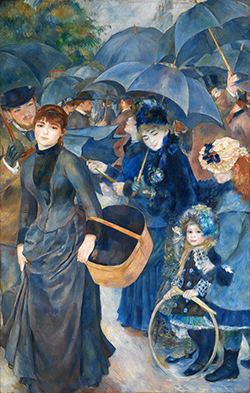 Painting by Pierre-Auguste Renoir: The Umbrellas (French: Les Parapluies) is an oil-on-canvas painting, painted in two phases in the 1880s. It is owned by the National Gallery in London as part of the Lane Bequest, but is displayed alternately in London and at the Dublin City Gallery The Hugh Lane. In May 2013, it returned to Dublin for a six-year period. Renoir began the painting in about 1880-81, using the loose brushwork with dark and bright tones typical of the Impressionist movement. In about 1885-6, after losing his attachment to Impressionism and drawing inspiration from classical art he had seen in Italy and the works of Ingres and Cézanne, he reworked parts of the painting, particularly the principal female figure to the left of the frame, in a more classical linear style using more muted colours, and added the background and the umbrellas themselves. X-ray photography has shown that the clothing of the female figure was originally different: she wore a hat and her dress had horizontal rows of frills, with white lace at its cuffs and collar, suggesting that she was middle class, whereas the simpler clothes in the revised painting mark her out as a member of the working class, a grisette not a bourgeoise. The x-ray analysis and then the changing fashions allow the periods of work to be dated with reasonable accuracy.
Painting by Pierre-Auguste Renoir: The Umbrellas (French: Les Parapluies) is an oil-on-canvas painting, painted in two phases in the 1880s. It is owned by the National Gallery in London as part of the Lane Bequest, but is displayed alternately in London and at the Dublin City Gallery The Hugh Lane. In May 2013, it returned to Dublin for a six-year period. Renoir began the painting in about 1880-81, using the loose brushwork with dark and bright tones typical of the Impressionist movement. In about 1885-6, after losing his attachment to Impressionism and drawing inspiration from classical art he had seen in Italy and the works of Ingres and Cézanne, he reworked parts of the painting, particularly the principal female figure to the left of the frame, in a more classical linear style using more muted colours, and added the background and the umbrellas themselves. X-ray photography has shown that the clothing of the female figure was originally different: she wore a hat and her dress had horizontal rows of frills, with white lace at its cuffs and collar, suggesting that she was middle class, whereas the simpler clothes in the revised painting mark her out as a member of the working class, a grisette not a bourgeoise. The x-ray analysis and then the changing fashions allow the periods of work to be dated with reasonable accuracy.
Walther Flemming publishes accurate depictions of cell division (mitosis) in Zellsubstanz, Kern und Zelltheilung.
 Eduard Strasburger coins the terms CYTOPLASM and NUCLEOPLASM.
Eduard Strasburger coins the terms CYTOPLASM and NUCLEOPLASM.
 W. Flemming discovers lampbrush chromosomes and coins the term MITOSIS.
W. Flemming discovers lampbrush chromosomes and coins the term MITOSIS.
Karl Alfred von Zittel describes an exceptionally well-preserved pterosaur wing showing flight membranes in detail.
Charles Darwin publishes his final letter to Nature, on the dispersal of freshwater bivalves. His obituary appears the same month. In this paper, Darwin acknowledges the assistance of W. D. Crick or Northampton. Later, Crick's grandson — Francis Crick — will be one of the co- discoverers of the structure of DNA.
1882
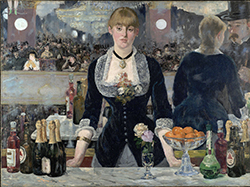 Painting by Édouard Manet: A Bar at the Folies-Bergère (French: Un bar aux Folies Bergère), is considered Manet's last major work. It depicts a scene in the Folies Bergère nightclub in Paris. It originally belonged to the composer Emmanuel Chabrier, who was Manet's neighbor, and hung over his piano. The painting exemplifies Manet's commitment to Realism in its detailed representation of a contemporary scene. Many features have puzzled critics but almost all of them have been shown to have a rationale, and the painting has been the subject of numerous popular and scholarly articles. The central figure stands before a mirror, although critics — accusing Manet of ignorance of perspective and alleging various impossibilities in the painting — have debated this point since the earliest reviews were published. In 2000, however, a photograph taken from a suitable point of view of a staged reconstruction was shown to reproduce the scene as painted by Manet.
Painting by Édouard Manet: A Bar at the Folies-Bergère (French: Un bar aux Folies Bergère), is considered Manet's last major work. It depicts a scene in the Folies Bergère nightclub in Paris. It originally belonged to the composer Emmanuel Chabrier, who was Manet's neighbor, and hung over his piano. The painting exemplifies Manet's commitment to Realism in its detailed representation of a contemporary scene. Many features have puzzled critics but almost all of them have been shown to have a rationale, and the painting has been the subject of numerous popular and scholarly articles. The central figure stands before a mirror, although critics — accusing Manet of ignorance of perspective and alleging various impossibilities in the painting — have debated this point since the earliest reviews were published. In 2000, however, a photograph taken from a suitable point of view of a staged reconstruction was shown to reproduce the scene as painted by Manet.
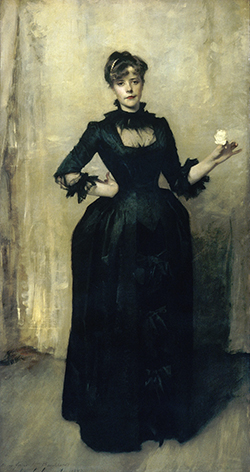 Painting by John Singer Sargent: Lady with the Rose (Charlotte Louise Burckhardt). The subject of this portrait was the twenty-year-old daughter of a Swiss merchant and his American wife, members of the artist's cosmopolitan circle in Paris. Did she enjoy the experience? Look at her expression.
Painting by John Singer Sargent: Lady with the Rose (Charlotte Louise Burckhardt). The subject of this portrait was the twenty-year-old daughter of a Swiss merchant and his American wife, members of the artist's cosmopolitan circle in Paris. Did she enjoy the experience? Look at her expression.
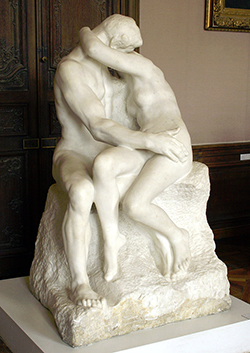 Sculpture by Auguste Rodin: The sculpture, The Kiss, was originally titled Francesca da Rimini, as it depicts the 13th-century Italian noblewoman immortalised in Dante's Inferno (Circle 2, Canto 5) who falls in love with her husband Giovanni Malatesta's younger brother Paolo. Having fallen in love while reading the story of Lancelot and Guinevere, the couple are discovered and killed by Francesca's husband. In the sculpture, the book can be seen in Paolo's hand. The lovers' lips do not actually touch in the sculpture, suggesting that they were interrupted and met their demise without their lips ever having touched. When critics first saw the sculpture in 1887, they suggested the less specific title Le Baiser (The Kiss).
Sculpture by Auguste Rodin: The sculpture, The Kiss, was originally titled Francesca da Rimini, as it depicts the 13th-century Italian noblewoman immortalised in Dante's Inferno (Circle 2, Canto 5) who falls in love with her husband Giovanni Malatesta's younger brother Paolo. Having fallen in love while reading the story of Lancelot and Guinevere, the couple are discovered and killed by Francesca's husband. In the sculpture, the book can be seen in Paolo's hand. The lovers' lips do not actually touch in the sculpture, suggesting that they were interrupted and met their demise without their lips ever having touched. When critics first saw the sculpture in 1887, they suggested the less specific title Le Baiser (The Kiss).
 August Weismann points out the distinction in animals between the somatic cell line and the germ cells, stressing that only changes in germ cells are transmitted to further generations.
August Weismann points out the distinction in animals between the somatic cell line and the germ cells, stressing that only changes in germ cells are transmitted to further generations.
 Edouard van Beneden announced the principles of genetic continuity of chromosomes and reported the occurrence of chromosome reduction at germ cell formation. The sperm and egg are haploid and fertilization restores the diploid chromosome number.
Edouard van Beneden announced the principles of genetic continuity of chromosomes and reported the occurrence of chromosome reduction at germ cell formation. The sperm and egg are haploid and fertilization restores the diploid chromosome number.
 Wilhelm Roux offers a possible explanation for the function of mitosis.
Wilhelm Roux offers a possible explanation for the function of mitosis.
 William Keith Brooks, a professor at The Johns Hopkins University, publishes The Law of Heredity: A Study of the Cause of Variation and the Origin of Living Organisms. Although this speculative work did not significantly advance the understanding of heredity, brooks' thinking is important because during his career he provided instruction to and supervised the early research of Thomas H. Morgan, Edmund Beecher Wilson, and William Bateson — ultimately some of the most important contributors to the new science of genetics.
William Keith Brooks, a professor at The Johns Hopkins University, publishes The Law of Heredity: A Study of the Cause of Variation and the Origin of Living Organisms. Although this speculative work did not significantly advance the understanding of heredity, brooks' thinking is important because during his career he provided instruction to and supervised the early research of Thomas H. Morgan, Edmund Beecher Wilson, and William Bateson — ultimately some of the most important contributors to the new science of genetics.
 Pierre Émile Duclaux introduces the custom of designating an enzyme by the by the name of the substrate on which its action was first reported and adding the suffix -ase.
Pierre Émile Duclaux introduces the custom of designating an enzyme by the by the name of the substrate on which its action was first reported and adding the suffix -ase.
1883
(no entry for this year)



 During 1884-88, identification of the cell nucleus as the basis for inheritance was independently reported by Oscar Hertwig, Eduard Strasburger, Albrecht von Kölliker, and August Weismann.
During 1884-88, identification of the cell nucleus as the basis for inheritance was independently reported by Oscar Hertwig, Eduard Strasburger, Albrecht von Kölliker, and August Weismann.
 Gregor Mendel dies on January 6th, without ever knowing that his work on peas would lead to the transformation of biological research.
Gregor Mendel dies on January 6th, without ever knowing that his work on peas would lead to the transformation of biological research.


 Walther Flemming, Eduard Strasburger and Edouard van Beneden demonstrate that chromosome doubling occurs by a process of longitudinal splitting. Strasburger describes and names the PROPHASE, METAPHASE, and ANAPHASEstages of chromosomal division.
Walther Flemming, Eduard Strasburger and Edouard van Beneden demonstrate that chromosome doubling occurs by a process of longitudinal splitting. Strasburger describes and names the PROPHASE, METAPHASE, and ANAPHASEstages of chromosomal division.
1884
(no entry for this year)
 August Weismann formulates the germ-plasm theory which held that the germ plasm was separate from the somatoplasm and was continuous from generation to generation.
August Weismann formulates the germ-plasm theory which held that the germ plasm was separate from the somatoplasm and was continuous from generation to generation.
 Carl Rabl theorized the individuality of chromosomes in all stages of the cell cycle.
Carl Rabl theorized the individuality of chromosomes in all stages of the cell cycle.
 Walther Flemming observed sister chromatids passing to opposite poles of the cell during mitosis.
Walther Flemming observed sister chromatids passing to opposite poles of the cell during mitosis.
1885
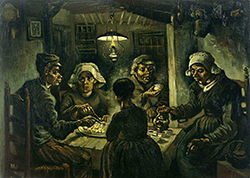 Painting by Vincent van Gogh: The Potato Eaters (Dutch: De Aardappeleters). Van Gogh said he wanted to depict peasants as they really were. He deliberately chose coarse and ugly models, thinking that they would be natural and unspoiled in his finished work: "You see, I really have wanted to make it so that people get the idea that these folk, who are eating their potatoes by the light of their little lamp, have tilled the earth themselves with these hands they are putting in the dish, and so it speaks of manual labor and — that they have thus honestly earned their food. I wanted it to give the idea of a wholly different way of life from ours — civilized people. So I certainly don't want everyone just to admire it or approve of it without knowing why."
Painting by Vincent van Gogh: The Potato Eaters (Dutch: De Aardappeleters). Van Gogh said he wanted to depict peasants as they really were. He deliberately chose coarse and ugly models, thinking that they would be natural and unspoiled in his finished work: "You see, I really have wanted to make it so that people get the idea that these folk, who are eating their potatoes by the light of their little lamp, have tilled the earth themselves with these hands they are putting in the dish, and so it speaks of manual labor and — that they have thus honestly earned their food. I wanted it to give the idea of a wholly different way of life from ours — civilized people. So I certainly don't want everyone just to admire it or approve of it without knowing why."
 Francis Galton devised a new useful statistical tool, the correlation table.
Francis Galton devised a new useful statistical tool, the correlation table.
 Hugo de Vries (Holland) discovers aberrant evening primrose plants at Hilversum, Holland. Experiments with these extending over 15 years formed the basis for his mutation theory of evolution.
Hugo de Vries (Holland) discovers aberrant evening primrose plants at Hilversum, Holland. Experiments with these extending over 15 years formed the basis for his mutation theory of evolution.
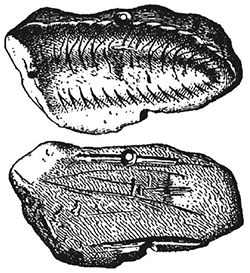 A. Ficatier publishes an account of the discovery of a trilobite perforated with two holes (perhaps to hang on a thread) at a Magdalenian- age site in France. The fossil lends the site its name of La Grotte du Trilobite.
A. Ficatier publishes an account of the discovery of a trilobite perforated with two holes (perhaps to hang on a thread) at a Magdalenian- age site in France. The fossil lends the site its name of La Grotte du Trilobite.
John Bell Hatcher develops the "ant hill method of collecting minute fossils," collecting hundreds of tiny fossil teeth and jaws pushed to the surface by ants. He even carries shovelfuls of ants and sediment to other fossil localities in need of excavation by the arthropods.
1886
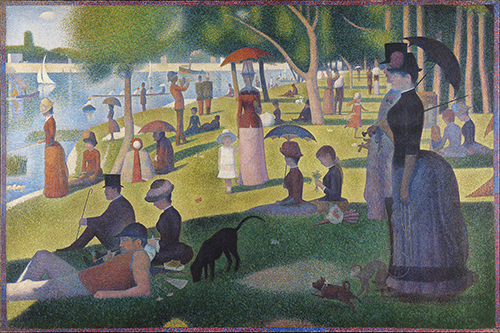 Painting by Georges Seurat: A Sunday Afternoon on the Island of La Grande Jatte (French: Un dimanche après-midi à l'Île de la Grande Jatte) is one of the artist's most famous works. It is a leading example of pointillism technique, executed on a large canvas. Seurat's composition includes a number of Parisians at a park on the banks of the River Seine. Inspired by optical effects and perception inherent in the color theories of Michel Eugène Chevreul, Ogden Rood and others, Seurat adapted this scientific research to his painting. Seurat contrasted miniature dots or small brushstrokes of colors that when unified optically in the human eye were perceived as a single shade or hue. He believed that this form of painting, called divisionism at the time but now known as pointillism, would make the colors more brilliant and powerful than standard brushstrokes.
Painting by Georges Seurat: A Sunday Afternoon on the Island of La Grande Jatte (French: Un dimanche après-midi à l'Île de la Grande Jatte) is one of the artist's most famous works. It is a leading example of pointillism technique, executed on a large canvas. Seurat's composition includes a number of Parisians at a park on the banks of the River Seine. Inspired by optical effects and perception inherent in the color theories of Michel Eugène Chevreul, Ogden Rood and others, Seurat adapted this scientific research to his painting. Seurat contrasted miniature dots or small brushstrokes of colors that when unified optically in the human eye were perceived as a single shade or hue. He believed that this form of painting, called divisionism at the time but now known as pointillism, would make the colors more brilliant and powerful than standard brushstrokes.
 August Weismann elaborated an all-encompassing theory of chromosome behavior during cell division and fertilization and predicted the occurrence of a reduction division (meiosis) in all sexual organisms.
August Weismann elaborated an all-encompassing theory of chromosome behavior during cell division and fertilization and predicted the occurrence of a reduction division (meiosis) in all sexual organisms.
 Edouard van Beneden demonstrated chromosome reduction in gamete maturation, thereby confirming August Weismann's predictions.
Edouard van Beneden demonstrated chromosome reduction in gamete maturation, thereby confirming August Weismann's predictions.
 Wilhelm Roux put forth the suggestion that the linearly arranged qualities of the chromosomes were equally transmitted to both daughter cells at meiosis.
Wilhelm Roux put forth the suggestion that the linearly arranged qualities of the chromosomes were equally transmitted to both daughter cells at meiosis.
 Harry Govier Seeley determines that dinosaurs consist of "lizard- hipped" (saurischian) and "bird-hipped" (ornithischian) branches.
Harry Govier Seeley determines that dinosaurs consist of "lizard- hipped" (saurischian) and "bird-hipped" (ornithischian) branches.
1887
(no entry for this year)
German anatomist W. von Waldeyer names chromosomes.
 Heinrich Wilhelm Gottfried von Waldeyer names the CHROMOSOME.
Heinrich Wilhelm Gottfried von Waldeyer names the CHROMOSOME.
 Theodor Boveri verifies August Weismann's predictions of chromosome reduction by direct observation in Ascaris.
Theodor Boveri verifies August Weismann's predictions of chromosome reduction by direct observation in Ascaris.
1888
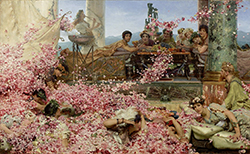 Painting by Sir Lawrence Alma-Tadema: The Roses of Heliogabalus shows a group of Roman diners at a banquet, being swamped by drifts of pink rose petals falling from a false ceiling above. The Roman emperor Elagabalus reclines on a platform behind them, wearing a golden robe and a tiara, watching the spectacle with other garlanded guests. A woman plays the double pipes beside a marble pillar in the background, wearing the leopard skin of a maenad, with a bronze statue of Dionysus, based on the Ludovisi Dionysus, in front of a view of distant hills. The painting depicts a (probably invented) episode in the life of the Roman emperor Elagabalus, also known as Heliogabalus, (204–222), taken from the Augustan History. Although the Latin refers to "violets and other flowers", Alma-Tadema depicts Elagabalus smothering his unsuspecting guests with rose petals released from a false ceiling.
Painting by Sir Lawrence Alma-Tadema: The Roses of Heliogabalus shows a group of Roman diners at a banquet, being swamped by drifts of pink rose petals falling from a false ceiling above. The Roman emperor Elagabalus reclines on a platform behind them, wearing a golden robe and a tiara, watching the spectacle with other garlanded guests. A woman plays the double pipes beside a marble pillar in the background, wearing the leopard skin of a maenad, with a bronze statue of Dionysus, based on the Ludovisi Dionysus, in front of a view of distant hills. The painting depicts a (probably invented) episode in the life of the Roman emperor Elagabalus, also known as Heliogabalus, (204–222), taken from the Augustan History. Although the Latin refers to "violets and other flowers", Alma-Tadema depicts Elagabalus smothering his unsuspecting guests with rose petals released from a false ceiling.
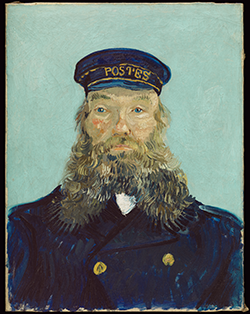 Painting by Vincent Van Gogh: Portrait of Postman Roulin. In February 1888 Van Gogh moved to Arles, in the south of France, and continued to paint landscapes and portraits. Between late July 1888 and April 1889, he painted at least six portraits of Joseph-Etienne Roulin (1841–1903), a postman in Arles. Here, the artist concentrated on Roulin's head, which he described in a letter as "somewhat like Socrates, hardly any nose at all, a high forehead, bald crown, little gray eyes, bright red chubby cheeks, a big pepper-and-salt beard, large eyes."
Painting by Vincent Van Gogh: Portrait of Postman Roulin. In February 1888 Van Gogh moved to Arles, in the south of France, and continued to paint landscapes and portraits. Between late July 1888 and April 1889, he painted at least six portraits of Joseph-Etienne Roulin (1841–1903), a postman in Arles. Here, the artist concentrated on Roulin's head, which he described in a letter as "somewhat like Socrates, hardly any nose at all, a high forehead, bald crown, little gray eyes, bright red chubby cheeks, a big pepper-and-salt beard, large eyes."
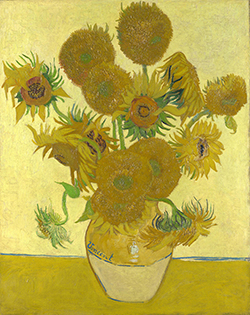 Painting by Vincent van Gogh: Sunflowers (original title, in French: Tournesols). Sunflowers are the subject of two series of still life paintings by the Dutch painter . The earlier series, executed in Paris in 1887, depicts the flowers lying on the ground, while the second set, executed a year later in Arles, shows bouquets of sunflowers in a vase. In the artist's mind both sets were linked by the name of his friend Paul Gauguin, who acquired two of the Paris versions. About eight months later van Gogh hoped to welcome and to impress Gauguin again with Sunflowers, now part of the painted Décoration for the Yellow House that he prepared for the guestroom of his home in Arles, where Gauguin was supposed to stay. After Gauguin's departure, van Gogh imagined the two major versions as wings of the Berceuse Triptych, and finally he included them in his Les XX in Bruxelles exhibit
Painting by Vincent van Gogh: Sunflowers (original title, in French: Tournesols). Sunflowers are the subject of two series of still life paintings by the Dutch painter . The earlier series, executed in Paris in 1887, depicts the flowers lying on the ground, while the second set, executed a year later in Arles, shows bouquets of sunflowers in a vase. In the artist's mind both sets were linked by the name of his friend Paul Gauguin, who acquired two of the Paris versions. About eight months later van Gogh hoped to welcome and to impress Gauguin again with Sunflowers, now part of the painted Décoration for the Yellow House that he prepared for the guestroom of his home in Arles, where Gauguin was supposed to stay. After Gauguin's departure, van Gogh imagined the two major versions as wings of the Berceuse Triptych, and finally he included them in his Les XX in Bruxelles exhibit
 Francis Galton publishes Natural Inheritance. In it he describes the quantitative measurement of metric traits in populations. He thus founds biometry and the statistical study of variation. Ultimately, he formulates the Law of Ancestral Inheritance, a statistical description of the relative contributions to heredity made by one's ancestors.
Francis Galton publishes Natural Inheritance. In it he describes the quantitative measurement of metric traits in populations. He thus founds biometry and the statistical study of variation. Ultimately, he formulates the Law of Ancestral Inheritance, a statistical description of the relative contributions to heredity made by one's ancestors.
1889
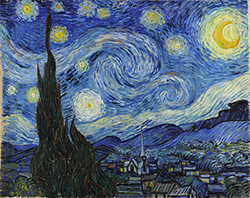 Painting by Vincent van Gogh: The Starry Night depicts the view from the east-facing window of his asylum room at Saint-Rémy-de-Provence, just before sunrise, with the addition of an idealized village. It is regarded as among Van Gogh's finest works, and is one of the most recognized paintings in the history of Western culture. In the aftermath of the 23 December 1888 breakdown that resulted in the self-mutilation of his left ear, Van Gogh voluntarily admitted himself to the Saint-Paul-de-Mausole lunatic asylum on 8 May 1889. Housed in a former monastery, Saint-Paul-de-Mausole catered to the wealthy and was less than half full when Van Gogh arrived, allowing him to occupy not only a second-story bedroom but also a ground-floor room for use as a painting studio.
Painting by Vincent van Gogh: The Starry Night depicts the view from the east-facing window of his asylum room at Saint-Rémy-de-Provence, just before sunrise, with the addition of an idealized village. It is regarded as among Van Gogh's finest works, and is one of the most recognized paintings in the history of Western culture. In the aftermath of the 23 December 1888 breakdown that resulted in the self-mutilation of his left ear, Van Gogh voluntarily admitted himself to the Saint-Paul-de-Mausole lunatic asylum on 8 May 1889. Housed in a former monastery, Saint-Paul-de-Mausole catered to the wealthy and was less than half full when Van Gogh arrived, allowing him to occupy not only a second-story bedroom but also a ground-floor room for use as a painting studio.
ESP Quick Facts
ESP Origins
In the early 1990's, Robert Robbins was a faculty member at Johns Hopkins, where he directed the informatics core of GDB — the human gene-mapping database of the international human genome project. To share papers with colleagues around the world, he set up a small paper-sharing section on his personal web page. This small project evolved into The Electronic Scholarly Publishing Project.
ESP Support
In 1995, Robbins became the VP/IT of the Fred Hutchinson Cancer Research Center in Seattle, WA. Soon after arriving in Seattle, Robbins secured funding, through the ELSI component of the US Human Genome Project, to create the original ESP.ORG web site, with the formal goal of providing free, world-wide access to the literature of classical genetics.
ESP Rationale
Although the methods of molecular biology can seem almost magical to the uninitiated, the original techniques of classical genetics are readily appreciated by one and all: cross individuals that differ in some inherited trait, collect all of the progeny, score their attributes, and propose mechanisms to explain the patterns of inheritance observed.
ESP Goal
In reading the early works of classical genetics, one is drawn, almost inexorably, into ever more complex models, until molecular explanations begin to seem both necessary and natural. At that point, the tools for understanding genome research are at hand. Assisting readers reach this point was the original goal of The Electronic Scholarly Publishing Project.
ESP Usage
Usage of the site grew rapidly and has remained high. Faculty began to use the site for their assigned readings. Other on-line publishers, ranging from The New York Times to Nature referenced ESP materials in their own publications. Nobel laureates (e.g., Joshua Lederberg) regularly used the site and even wrote to suggest changes and improvements.
ESP Content
When the site began, no journals were making their early content available in digital format. As a result, ESP was obliged to digitize classic literature before it could be made available. For many important papers — such as Mendel's original paper or the first genetic map — ESP had to produce entirely new typeset versions of the works, if they were to be available in a high-quality format.
ESP Help
Early support from the DOE component of the Human Genome Project was critically important for getting the ESP project on a firm foundation. Since that funding ended (nearly 20 years ago), the project has been operated as a purely volunteer effort. Anyone wishing to assist in these efforts should send an email to Robbins.
ESP Plans
With the development of methods for adding typeset side notes to PDF files, the ESP project now plans to add annotated versions of some classical papers to its holdings. We also plan to add new reference and pedagogical material. We have already started providing regularly updated, comprehensive bibliographies to the ESP.ORG site.
ESP Picks from Around the Web (updated 06 MAR 2017 )
Old Science

Weird Science

Treating Disease with Fecal Transplantation
Fossils of miniature humans (hobbits) discovered in Indonesia

Dinosaur tail, complete with feathers, found preserved in amber.
Astronomy

Mysterious fast radio burst (FRB) detected in the distant universe.